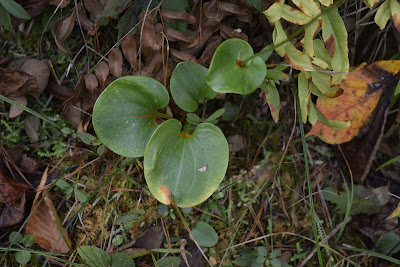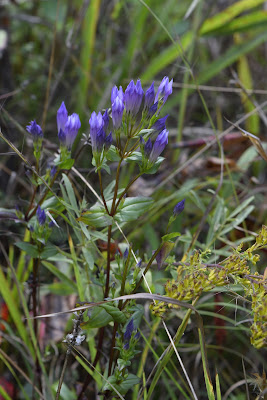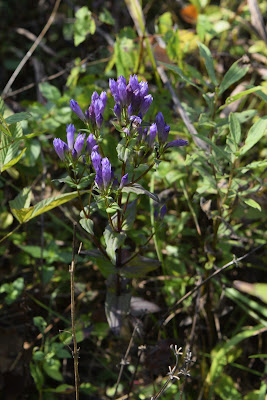Chris and I met up with some members of the Georgia Botanical Society to visit 2 sites we had wanted to see. There were about 25 of us who caravaned to the sites. Missing was our mentor and friend Tom Patrick who lost his battle with cancer a couple of months ago. Tom's vast knowledge about trilliums inspired me to pursue the study of this wondrous spring-blooming flower.
We had barely entered the Brasstown Valley State Park before we spotted Nodding Ladies' Tresses (Spiranthes cernua).
We were accompanied by several knowledgeable naturalists who willingly shared their expertise.We learned that of two species of Grass-of-Parnassus which grow in the mountainous regions of North Georgia, it is Parnassia grandifolia that grows in the seep at the edge of the park.
I photographed the Grass-of-Parnassus (Parnassia asarifolia) pictured below at an extremely high elevation in the Blue Ridge Mountains. Notice the vein pattern on the petals. Almost each of the veins branches at the tips unlike P. grandifolia whose veins branch at the lower edges near the ovary.
Monkshood (Aconitum uncinatum) was a pleasant surprise for us! We had seen this plant at a previous site in North Carolina the day before. It is named Aconitum because of the deadly poison aconite found in its stems, leaves, roots and blooms. The common name Monkshood comes from the shape of the flower which resembles the cowl of a monk.
The naturalists with us laughed when someone asked the identity of this composite. Most folks merely refer to such plants as DYCs, Darn Yellow Composites. Look closely on one of the rays to spot the camouflaged beetle whose attire perfectly coordinates with the flower.
Our group scattered out along the ridge spotting and identifying various plants. Looking back down the "trail," we had a lovely view of the valley and opposite ridge.
The higher up the ridge we explored, the more abundant the Grass-of-Parnassus became.
A veritable bouquet of early fall blooming plants were scattered around this site: Grass-of-Parnassus, Ladies' Tresses, Calico Aster, Black-eyed Susan.
We came across large patches of Nodding Ladies' Tresses.
A boundary marker indicates the beginning of the area we investigated at our first stop. From this site, we drove a short distance to check on the status of another site, one known for its 2 types of rare gentians. Unfortunately, the mower beat us to it! Sigh... A neighbor who each year puts out a DO NOT MOW sign, was 2 days late, so the bank was butchered.
Large Fringed Gentian (Gentianopsis crinita) and Stiff Gentian/Ague Weed (Gentianella quinquefolia) grow together along this bank.
We managed to find a few which survived the mower.
However, we did not totally despair! Just down the lane was another site which had the Fringed Gentians in abundance growing in a meadow with its companion Stiff Gentian.
The deep purple-blue of this lovely flower is due to the magnesium content in the soil.
The delicate fringes on the petal edges are a lovely feature of this flower.
I love spending time with this flower! I get immersed in the gorgeous satiny color.
Some of the Stiff Gentians were tall with scattered blooms.
Some of the Stiff Gentian blooms were pale lavender.
Notice the bee guides leading deeper into the corolla.
Sometimes the Stiff Gentian inflorescence reminded me of a candelabra.
Some Stiff Gentian flowers were very deep purple and robust
At the edge of the field was the ubiquitous Wingstem . However, I learned that this species of Wingstem, Alternate-leaf Wingstem (Actinomeris alternifolia) is not the one commonly found in East Tennesse
I thought its fruit capsules were quite interesting!
Disclaimer: Because I enjoy looking at Fringed Gentians in all their glory, I will not apologize for the number of pictures I included in this blog!
















































No comments:
Post a Comment